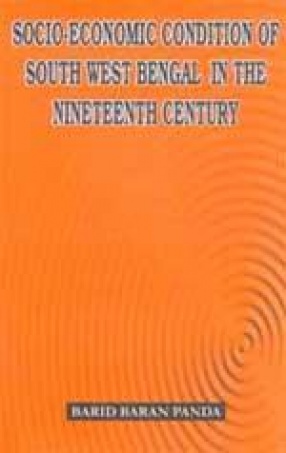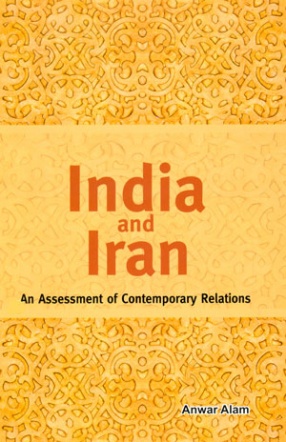The present volume is not only a chronological record of historical events that decided the political fate but also the Socio-Economic history of a turbulent region which the author rightly defines as the South West Bengal of the nineteenth century. It’s territorial jurisdiction began to fluctuate with the addition and deletion of territories as a consequence of intercine feuds between the native chiefs and the alien rulers and also to suit for the latter’s administrative convenience. The period from 1805 i.e. the year of creation of the jungle Mahal district, which ultimately lost its identity in modern Bankura in 1833 to 1885 when the Bengal tenancy Act was enacted and breadly upto the end of the nineteenth century has been selected for the present study. This is a period of transition in the agrarian economy of this region which spelt the end of the feudal agrarian land relations in Eastern India and heralded the dawn of a capitalist economy characterized by the building up of factories and rail-roads and associated phenomena of the steam age of India. Within these ninety five years of the British rule, the frontier line of the Bengal Presidency had been continuously extended like the ‘wild west’ of the United States of America till in the last half of the nineteenth century it included the Nimki Mahals (salt tracts) of Midnapore district and outlying Jungle Mahals (forest tracts) with Bhun-suffix, some of which were absorbed later in the districts of Bankura and Midnapore. In 1803, Puri, Cuttact and Balasore, three coastal districts of Orissa of about 3, 907 sq. miles were ceded to the Bengal Presidency from the Kingdom of the Bhonsles of Nagpur, this extending further the frontier of South West Bengal. In 1805, the jungle Mahal district was created by the Company’s government to Safeguard against any possible peasantised tribal resistance movements. But in sporadic agrarian revolts became widespread. Eventually in 1833, the year of the Charter Act, the Jungle Mahal district was abolished, and changes in the administrative machinery were introduced with a view to safequard the interest of the primary producers. In 1834 the town of Bankura was transferred from the South West Frontier agency to Burdwan and a Joint Magistrate and Deputy Collector were placed in charge of ‘Bishnupur’ with headquarters at Bankura. But Bankura district attained its present dimensions in 1879 when the subdivision of Bishnupur was created. It was not until 1881 that a separate District Judgeship for Bankura and an administrative unit were created. Thus the two districts of Midnapore and Bankura included the truncated portions of three contiguous provinces of Bengal. Bihar and Orissa of eastern India with ethnic, cultural and geographical homogeneity which is the locale of the present research study. The years 1850 and 1885 were significant for the present study since Rent Act X of 1859 and Tenancy Act VIII of 1885 constituted landmarks in the agrarian history of Bengal. Throughout the nineteenth century efforts were made to improve agriculture as well as the material condition of the new land captains, endowed with paying capacity after the resumption of vast area of non-revenue paying holdings of the rising middle peasants. Welfare measures were adopted to irrigate land, embankments constructed and public health and education ensured for agricultural expansion. On the other hand, this period is marked by the introduction of ‘Laissez-faire’ in British India. The company abandoned its policy of investment in village crafts. Paving the way for importation of machine-made textile goods. The Charger Act of 1833 also facilitated the important of cheap Liverpool salt, which led to the change in company’s salt policy. The Railway lines were opened up in the last decade of the nineteenth century connecting the coastal region of Orissa with Calcutta and Madras, seats of two Presidency Governments.
Socio-Economic Condition of South West Bengal in the Nineteenth Century
$44.10
$49.00
In stock
Free & Quick Delivery Worldwide
All orders amounting to US$ 50 or more qualify for Free Delivery Worldwide. For orders less than US$ 50, we offer Standard Delivery at $14 per book.
ABOUT THE AUTHOR Barid Baran Panda
Born in 1945 Prof. Barid Bran Panda, passed B.A. with Honours in 1967, M.A. in History from the University of Burdwan in 1969. He was awarded Ph.D. in arts from the University of Burdwan in 1996 on the “Socio-economic Condition of South West Bengal in the nineteenth Century†(1805 to 1900 A.D.). He started his Career as Head of the Department of History, Saldiha College in 1970. He attended the workshop on Medieval Indian History organized by Aligarh Muslim University from Dec. 18th 1986 to January 2nd 1987 as a delegation among the College teachers of West Bengal. He had also attended the Seminar held in the University of Calcutta from February 17th to March 11th 1997 on the “transition and change in Indian Historyâ€. Besides he also attended many Seminars and Conferences held in different parts of India. He is now Reader and Head of the department of History, Saldiha College and associated with various academic works in the College and the University.
reviews
0 in total
Review by Anonymous
Be the first to review “Socio-Economic Condition of South West Bengal in the Nineteenth Century” Cancel reply
You must be logged in to post a review.
Bibliographic information
Title
Socio-Economic Condition of South West Bengal in the Nineteenth Century
Author
Edition
1st ed.
Publisher
ISBN
8186791523
Length
xvi+456p., Tables; Appendices; Bibliography; Index; 23cm.
Subjects
more by Barid Baran Panda see more
similar bookssee more
Indian Emigration
$15.30
$17.00
Medieval Punjab: Perspectives on Historiography and Polity (Volume II)
An intensive study of the ...
$29.70
$33.00





There are no reviews yet.